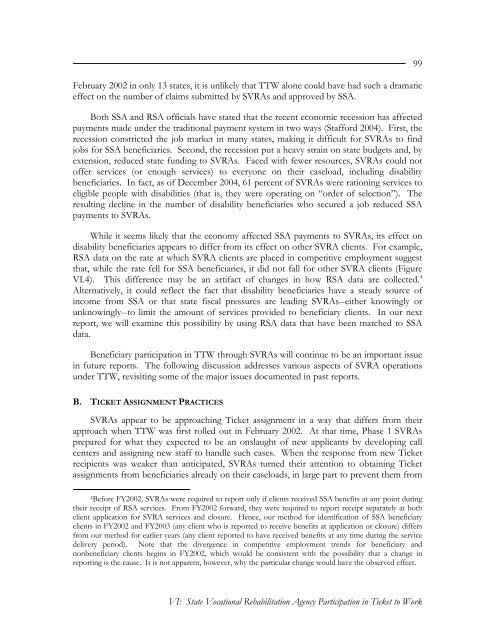Evaluation of the Ticket to Work Program, Implementation ...
Evaluation of the Ticket to Work Program, Implementation ...
Evaluation of the Ticket to Work Program, Implementation ...
Create successful ePaper yourself
Turn your PDF publications into a flip-book with our unique Google optimized e-Paper software.
February 2002 in only 13 states, it is unlikely that TTW alone could have had such a dramaticeffect on <strong>the</strong> number <strong>of</strong> claims submitted by SVRAs and approved by SSA.Both SSA and RSA <strong>of</strong>ficials have stated that <strong>the</strong> recent economic recession has affectedpayments made under <strong>the</strong> traditional payment system in two ways (Stafford 2004). First, <strong>the</strong>recession constricted <strong>the</strong> job market in many states, making it difficult for SVRAs <strong>to</strong> findjobs for SSA beneficiaries. Second, <strong>the</strong> recession put a heavy strain on state budgets and, byextension, reduced state funding <strong>to</strong> SVRAs. Faced with fewer resources, SVRAs could not<strong>of</strong>fer services (or enough services) <strong>to</strong> everyone on <strong>the</strong>ir caseload, including disabilitybeneficiaries. In fact, as <strong>of</strong> December 2004, 61 percent <strong>of</strong> SVRAs were rationing services <strong>to</strong>eligible people with disabilities (that is, <strong>the</strong>y were operating on “order <strong>of</strong> selection”). Theresulting decline in <strong>the</strong> number <strong>of</strong> disability beneficiaries who secured a job reduced SSApayments <strong>to</strong> SVRAs.While it seems likely that <strong>the</strong> economy affected SSA payments <strong>to</strong> SVRAs, its effect ondisability beneficiaries appears <strong>to</strong> differ from its effect on o<strong>the</strong>r SVRA clients. For example,RSA data on <strong>the</strong> rate at which SVRA clients are placed in competitive employment suggestthat, while <strong>the</strong> rate fell for SSA beneficiaries, it did not fall for o<strong>the</strong>r SVRA clients (FigureVI.4). This difference may be an artifact <strong>of</strong> changes in how RSA data are collected. 4Alternatively, it could reflect <strong>the</strong> fact that disability beneficiaries have a steady source <strong>of</strong>income from SSA or that state fiscal pressures are leading SVRAs--ei<strong>the</strong>r knowingly orunknowingly--<strong>to</strong> limit <strong>the</strong> amount <strong>of</strong> services provided <strong>to</strong> beneficiary clients. In our nextreport, we will examine this possibility by using RSA data that have been matched <strong>to</strong> SSAdata.Beneficiary participation in TTW through SVRAs will continue <strong>to</strong> be an important issuein future reports. The following discussion addresses various aspects <strong>of</strong> SVRA operationsunder TTW, revisiting some <strong>of</strong> <strong>the</strong> major issues documented in past reports.99B. TICKET ASSIGNMENT PRACTICESSVRAs appear <strong>to</strong> be approaching <strong>Ticket</strong> assignment in a way that differs from <strong>the</strong>irapproach when TTW was first rolled out in February 2002. At that time, Phase 1 SVRAsprepared for what <strong>the</strong>y expected <strong>to</strong> be an onslaught <strong>of</strong> new applicants by developing callcenters and assigning new staff <strong>to</strong> handle such cases. When <strong>the</strong> response from new <strong>Ticket</strong>recipients was weaker than anticipated, SVRAs turned <strong>the</strong>ir attention <strong>to</strong> obtaining <strong>Ticket</strong>assignments from beneficiaries already on <strong>the</strong>ir caseloads, in large part <strong>to</strong> prevent <strong>the</strong>m from4 Before FY2002, SVRAs were required <strong>to</strong> report only if clients received SSA benefits at any point during<strong>the</strong>ir receipt <strong>of</strong> RSA services. From FY2002 forward, <strong>the</strong>y were required <strong>to</strong> report receipt separately at bothclient application for SVRA services and closure. Hence, our method for identification <strong>of</strong> SSA beneficiaryclients in FY2002 and FY2003 (any client who is reported <strong>to</strong> receive benefits at application or closure) differsfrom our method for earlier years (any client reported <strong>to</strong> have received benefits at any time during <strong>the</strong> servicedelivery period). Note that <strong>the</strong> divergence in competitive employment trends for beneficiary andnonbeneficiary clients begins in FY2002, which would be consistent with <strong>the</strong> possibility that a change inreporting is <strong>the</strong> cause. It is not apparent, however, why <strong>the</strong> particular change would have <strong>the</strong> observed effect.VI: State Vocational Rehabilitation Agency Participation in <strong>Ticket</strong> <strong>to</strong> <strong>Work</strong>
















